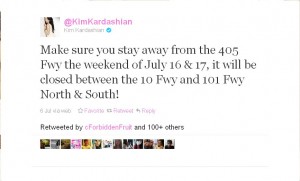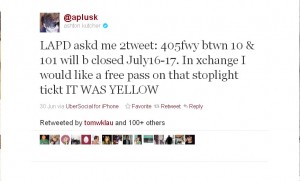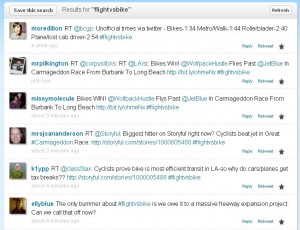Apparently Hitler drives a Prius.
The 405 freeway is an important artery in Los Angeles, and is one of the main ways of connecting the Westside to the Valley. There isn’t a train or bus route that effectively duplicates the route that the 405 takes, so shutting down the freeway for a weekend to demolish the Mulholland Drive Bridge as part of a highway widening project was considered a big deal for the residents of those neighborhoods. The build-up to the closing of the 405 was heralded by a massive public information campaign that could basically be summed up as “do not drive to the Westside on the weekend of July 16-17, because it will literally be hell on earth.” Granted, if Los Angeles, and particularly the Westside, were more multi-modal, the need for mass panic probably wouldn’t exist. It still would be a big deal but people wouldn’t be urged to just hide in their homes and barricade their doors. However, the information still needed to be disseminated.
Multiple public agencies and government officials were involved in communicating this effort to the public. The Los Angeles Police Department, Los Angeles Department of Transportation, Caltrans, Los Angeles City Mayor Antonio Villaraigosa, the Los Angeles County Board of Supervisors, Metro and many others, all worked to spread the information about the 405 freeway closure to prevent a potential traffic and public safety disaster.
However the information campaign wasn’t just focused on using freeway message signs, advertisements or holding yet another bland press conference. There was a huge move towards using social media to reach out to Los Angeles residents and tourists visiting this weekend to warn them about the potential impact of this project. In an especially creative move, the LAPD asked celebrities to tweet about the 405 closure.


Viral videos were created. Jay Leno did a bit on the 405 closure. The bit was actually kind of funny. (I know, my face burns with shame.)
Naturally, companies and businesses got in on the act as well, offering Carmageddon specials ($4.05 pints of beer) and selling Carmageddon t-shirts. Metro offered free rides on the Red, Purple and Orange Lines, as well as specific bus routes.
JetBlue offered $4 flights between Burbank and Long Beach that sold out in a matter of hours. This sparked a Twitter challenge from elite bicycle racing group Wolfpack Hustle. Who would win in a race from North Hollywood to Long Beach–someone riding the plane out of Burbank, someone exclusively taking public transportation or the elite cyclists taking the Los Angeles River Bicycle Path? The cyclists, and the person riding the Metro Red Line to the Metro Blue Line, beat Jet Blue to Long Beach. But Jet Blue, Wolfpack Hustle, the Los Angeles Bicycle Coalition and countless other cyclist advocacy groups managed to score quite a bit of local press coverage, and coverage on Twitter, less than a week before an anti-cyclist harassment ordinance goes before the Los Angeles City Council.
If you used the Twitter hashtags #FlightVsBike, #FlightVsMetro, or #MetroVsBike, (or a few variations), you could follow along with the action as @metrolosangeles, @LosAngelesCM, @LAStreetsblog and others Tweeted about the race on July 16th.

Traffic during the 405 closure on Saturday ended up being very mild. People were calling it Car2K and CarMeh on Twitter, and making jokes about this being Los Angeles post-Rapture. According to local news, people had little trouble getting to places like the Los Angeles International Airport, located just off the 405 and the 105. But does that mean that the huge media, press and public information build-up to the closure was pointless? Or does it mean that the campaign was successful, and Los Angeles residents responsibly heeded the warnings to stay home, or to use transit or ride their bikes instead of driving. It’s often hard to track the success of public information campaigns like this for that reason. You don’t realize something is working, until it doesn’t.
A lot of people are skeptical of Twitter, and other “social media” applications; some think of social media as the next big thing that is changing the world or starting revolutions (for good or bad.) But whatever side you take, the fact remains it can be used as a pretty effective communication tool, with a significant pass-along rate. When social media is used creatively and in conjunction with traditional methods, important information spreads rapidly–which is what you what with major public works efforts like shutting down a major freeway in a large city to demolish a bridge. Hopefully with good examples like #Carmageddon, more public agencies will embrace positive use of sites like Twitter and YouTube (instead of accidentally tweeting pictures of their peen.)
The 405 opened up to cars a day early, on July 17th, at 11:30 am, after an announcement at 11:00 am by public officials. The on-ramps that opened up were also announced on Twitter.